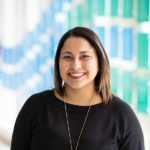Taking Research to the Public Library: Learning From One Initiative to Increase Health Literacy
Taking Research to the Public Library: Learning From One Initiative to Increase Health Literacy https://pediatricsnationwide.org/wp-content/uploads/2021/03/138017387-1024x683.jpg 1024 683 Adrianna Matos-Nieves Adrianna Matos-Nieves https://pediatricsnationwide.org/wp-content/uploads/2021/03/Adrianna-Matos.jpg- June 02, 2020
- Adrianna Matos-Nieves

Researchers from the Abigail Wexner Research Institute at Nationwide Children’s Hospital, visited the Columbus Metropolitan Library with the goal to improve health literacy in the Parsons community.
During the summer of 2019, when outings and gathering were still allowed, I received an outreach request from the Columbus Metropolitan Library (CML). It turns out the library hosts a College and Careers series over the summer in hopes of exposing 12 to 17-year-olds alternative career paths they might not have previously considered.
I confess that I hadn’t visited CML despite it being within walking distance to the Abigail Wexner Research Institute (AWRI) at Nationwide Children’s, where I am a PhD candidate and developmental biologist in the Center for Cardiovascular Research. Most of the science and health literacy outreach events I’ve coordinated happen within the AWRI.
I was surprised to see that despite it being the middle of the summer, the library was packed. Every computer was in use, teens would huddle in groups playing card games and summer-school homework assignments were underway.
I was asked to coordinate a presentation on gene therapy because the coordinator of the College and Career series thought “the kids would like it best.” I enlisted Shibi Likhite, PhD, who has been in the field of gene therapy for more than 10 years, and off we went. At the session, only two students and two librarians showed up to hear us. Initially, I was disappointed that more people wouldn’t hear us talk about one of the biggest achievements to come from Nationwide Children’s Hospital. But, I reminded myself of my favorite Malala Yousafzai quote “One child, one teacher, one book, one pen can change the world.” and committed to providing the best gene-therapy class the Parsons community has ever seen.
It was an intimate setting that allowed for a candid conversation on college, research, and inherited disease. The students were shocked to learn that the trainees at AWRI average nine-years of graduate education following their high-school graduation and they do so voluntarily. They learned human genetic basics from me and the basis of spinal muscular atrophy gene therapy treatment from Dr. Likhite. They asked many clarifying questions and challenged our methodology when we explained the need for animal models to perform research. Most importantly, they grasped the importance of biomedical research for human health and disease.
“There are kids in the Columbus community right now who are receiving this treatment and are surviving past the age of 2 because of it. This achievement would not be possible without their willingness to participate in clinical trials,” Dr. Likhite said when explaining the importance of gene therapy in detaining the progression of inherited muscular dystrophy. In the end, our four participants were grateful to have us at CML-Parsons and invited us back to give other science talks.
Engaging with our local community on the impact health-based research has on their lives is an important component of health literacy. Links have been found between health literacy with effective disease self-care, appropriate use of health care services, and recommended prevention behaviors such as vaccination, physical exercise, and avoiding tobacco products. Additionally, research suggests that health literacy can mitigate otherwise intractable health disparities among socially segmented subgroups in the United States.
In the age of COVID-19, when public health and the fight for misinformation are at the forefront of everyone’s mind, health literacy initiatives are needed to better address health concerns and outcomes.
Scientists and clinicians have a social responsibility to engage with members of their community. As the people closest to the genesis of knowledge and innovation, we owe it to others to communicate these findings in plain language. Here are some ways that you can help to improve health literacy in your community:
- If you are at Nationwide Children’s, you can connect with the sitting Research Institute Trainee Association Community Outreach Officer – they can help you connect to community partners in search of learning opportunities in Columbus, Ohio.
- Email libraries in your area and ask if they would consider hosting you for a presentation (in person or live stream)
- Sign up to participate in Skype a Scientist – a nonprofit organization that matches scientists to classrooms across the globe,
- Talk to teachers in your community – your science expertise could be a great topic for show and tell.
- Make time to check-in with patients after they have received a diagnosis and create a space that encourages clarifying questions.
References:
- Berkman ND, Sheridan SL, Donahue KE, et al. Health literacy interventions and outcomes: an updated systematic review. Evidence Reports/Technology Assessment (Full Rep). 2011;(199):1‐941.
- Characteristics of an Effective Health Education Curriculum. www.cdc.gov/healthyschools/sher/characteristics/index.htm
Image credit: Nationwide Children’s
About the author
Adrianna is a 5th year Ph.D. candidate in Dr. Vidu Garg's laboratory in the Center for Cardiovascular Research. Her research focuses on identifying novel genetic pathways involved in the development of the embryonic mouse heart. Outside of the lab, Adrianna is committed to ending science education disparities by facilitating community outreach events between scientists and the Columbus, Ohio community. She is set to graduate this Fall.
-
Adrianna Matos-Nieveshttps://pediatricsnationwide.org/author/adrianna-matos-nieves/
- Post Tags:
- Science Education and Outreach
- Posted In:
- Features
- Second Opinions




